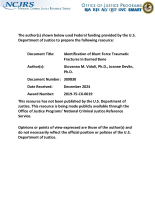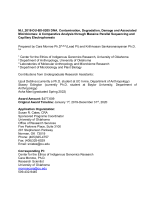Corpses
Detecting and Processing Clandestine Human Remains with Unmanned Aerial Systems and Multispectral Remote Sensing
Environmental Predictors Impact Microbial-based Postmortem Interval (PMI) Estimation Models within Human Decomposition Soils
Differential DNA Preservation of Thermally Altered Tissue and Bone
Advancing Justice for the Missing and Unidentified Through Research - 2024 NIJ Research Conference
Forensic science research is developing essential knowledge to fill in the holes in death investigations, creating new ways to identify challenging skeletal remains. These methods inform cause of death, time of death, and familial relationships to guide investigations, identify suspects, support prosecutions, and bring justice to families.
See the YouTube Terms of Service and Google Privacy Policy





